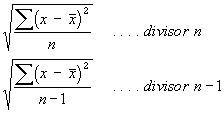one has DIVISOR n, the other has DIVISOR n-1


I am confused about all the different formulae for standard deviation. Which one should I use? |
Yes, it can be confusing, especially as different textbooks sometimes use different notation.
Basically there are two different standard deviations:
one has DIVISOR n, the other has DIVISOR n-1

Since there are too many modifications to list here, we strongly suggest you ask your tutor which ones to use, and ignore any others you might come across. For example, if you are working towards an exam, you might be given a Formula Sheet to refer to, so just practise using the particular formulae included there.
Nowadays, most pocket calculators include statistical functions built in. Such calculators have two buttons for standard deviations, one for the "divisor n" form and one for the "divisor n-1" form. Make sure you know which is which!
HINT
If in doubt, note that the standard deviation when working with a sample (divisor n-1)
will be slightly greater that the standard deviation when working with a population
(divisor n) because we are only dividing by n-1 rather than n.